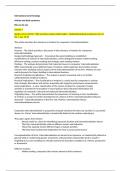Resume
International strategy summary book+articles
- Cours
- Établissement
- Book
This summary provides an overview of the book chapters and articles needed to prepare for the exam of International Strategy (Strategic Management, Tilburg University).
[Montrer plus]













